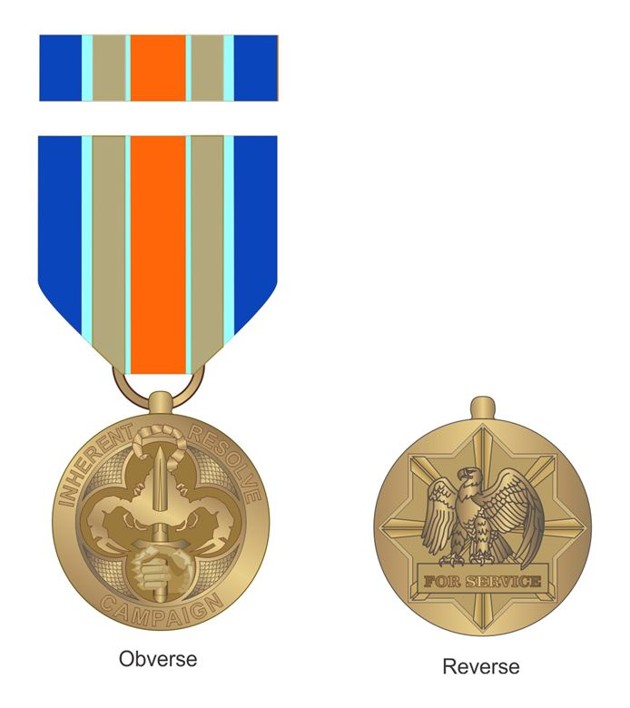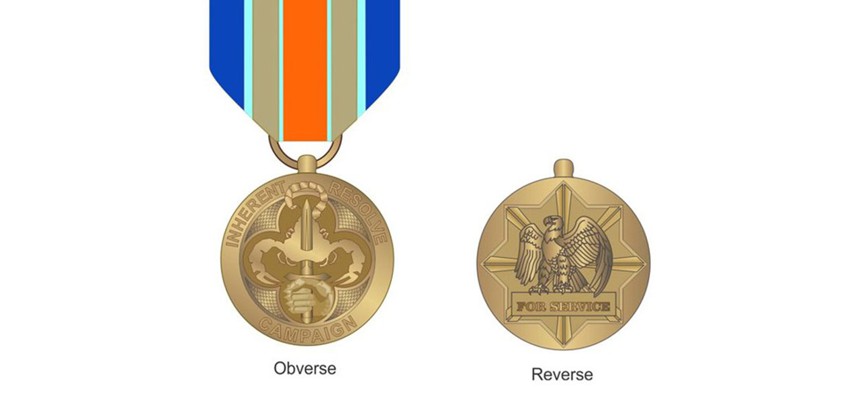The Symbolism of the New U.S. Medal for Fighting ISIS
A very close look at the military’s award for service in Syria and Iraq.
During the Crusades of the Middle Ages, a typical Frankish knight wore “a coat of chain mail or scale armour, [a] shield and a helmet,” Piers Mitchell tells us in hisbook on warfare and medicine during the period. The chain mail, a mesh formed with interlinked metal rings, offered protection, but only to a point: It “could still be penetrated by lance, cross-bow bolt and arrow and even cut with a heavy blow from a good sword.” It proved feebler against the mace and, I imagine, was of little use against the siege weapons of the day, which could “propel rocks, Greek fire, boiling oil and water and, on occasion, amputated body parts.”
Chain mail, of course, has gone the way of the mace and Greek fire, which is why it’s surprising to see the armor make a comeback in a medal that the U.S. Defense Department unveiled on Wednesday to recognize soldiers for their service in Iraq or Syria as part of Operation Inherent Resolve, the U.S.-led military operation against the Islamic State. The medal features a mail-cloaked hand clutching a sword—a curious image for a campaign that largely consists of air strikes and support for local ground forces.
More importantly, it’s surprising because ISIS, in its propaganda, often depicts the Western participants in that campaign as modern-day Christian Crusaders invading the Middle East once again. In claiming responsibility for the recent bombings in Brussels, for example, ISIS asserted that it was targeting “Crusader Belgium, which did not stop targeting Islam and its people.”
“The display of such martial imagery is somewhat ironic, as the Pentagon has often gone out of its way to play down U.S. involvement in combat operations” against ISIS in Iraq and Syria, Thomas Gibbons-Neff wrote in The Washington Poston Wednesday. The imagery might also “be construed to imply religious zealotry—insignia and call signs that invoke armor-clad crusaders have embroiled the U.S. military in controversy before. Last year, two Army units were criticized for using crusader names, shields and imagery in their unit logos.”
In a description of the new medal posted to the Institute of Heraldry’s website, the military points to “an erect dagger enfiled by a scorpion held by a mailed hand,” which, if nothing else, is colorful.

A depiction of the Battle of Hattin, which took place in 1187 between Crusader forces and armies under command of the Kurdish sultan Saladin. (Wikimedia Commons)
When I asked the Defense Department whether the mailed hand was an intentional allusion to the Crusades, I was referred to a more detailed description of the medal from the Institute of Heraldry, which characterized the hand as “armored” rather than “mailed,” and consistent with past U.S. military iconography. Here’s part of that description:
The armored hand clutching the dagger represents strength and courage in the defense of liberty and freedom. This armored hand is widely used in military heraldry for this purpose. One of the more notable military symbols incorporating the armored hand is [that of] the [United States Air Force] Strategic Air Command.
(A previous “global war on terrorism” medal featured an eagle—that most American of symbols—crushing a serpent in its claws, flanked by crisscrossed swords, which in spirit isn’t so far off from the new award.)
And what of the impaled scorpion? On its site, the Institute of Heraldry notes that “the scorpion, symbolic for treachery and destruction, is found on most major land masses.” You could reasonably read this as a message that the United States is determined to stop the Islamic State’s far-flung predations.
Or you could get a little carried away and interpret the choice of the ubiquitous scorpion as a subtle rebuke to the notion that ISIS, and Islamist militants more broadly, have a monopoly on violent ideological extremism in the world. Which, come to think of it, recalls something President Obama once said with regard to ISIS: “Lest we get on our high horse and think [people invoking religion to commit violence] is unique to some other place, remember that during the Crusades and the Inquisition, people committed terrible deeds in the name of Christ.”
NEXT STORY: Joint Chiefs Chairman: No, NATO’s Not Obsolete




